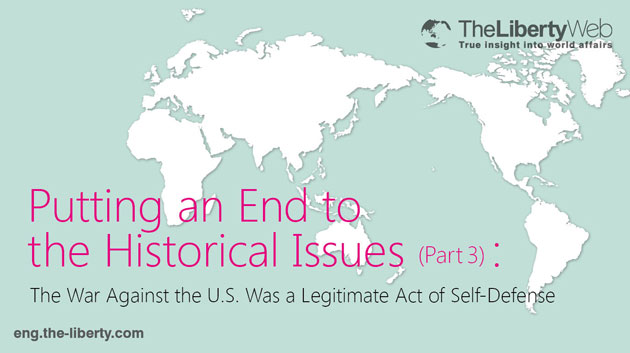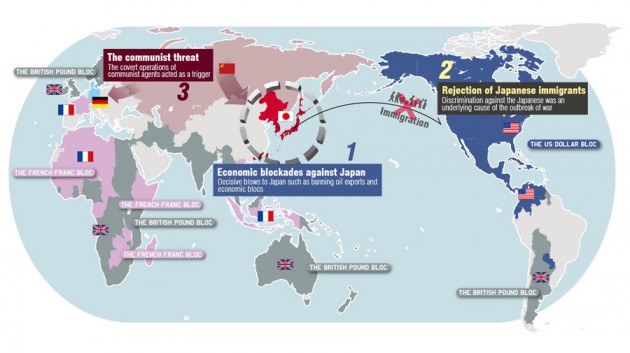Putting an End to the Historical Issues (Part 3):
The War Against the U.S. Was a Legitimate Act of Self-Defense
We will now review the historical issues that form a background for the Okawa Statement. Japan fought The Greater East Asian War over the course of 15 years. Why did Japan resort to war? Or rather, why was it forced to do so? Part 3 reviews the primary factors for the decision from three perspectives, which are “economic blockades against Japan”, “anti-Japanese movements”, and “Communist threats”.
1. Economic Blockades to Corner Japan
When the Great Depression began in 1929, countries like Britain and France that had many colonies aimed to overcome the recession via bloc economics, such as the imposition of high tariffs on trade with countries outside the commonwealths, which included their own colonies. Meanwhile, it was difficult for countries like Japan, Germany, and Italy, which did not possess many economic blocs, to revamp their own economies, and they were forced into a situation where they had no choice but to try to form new economic blocs.
After Japan founded Manchukuo, it moved into French Indochina. Countries, such as America, could not maintain their neutrality in the Second Sino-Japanese War, and they gave their assistance to the Chinese side. Therefore, Japan tried to block their supply routes. However, the allies used this as an excuse to impose the ABCD encirclement (see note 1) and to push Japan into a corner. This had been a lethal blow to the governing powers of Japan, which lacked resources such as oil, and leaders were forced to commit themselves to war. General MacArthur, who directed America’s strategies against Japan, testified in Congress after the war as follows, “Their (Japan’s) purpose, therefore, in going to war was largely dictated by security.”
(Note 1) A = The Americans, B = The British, C = The Chinese and D = The Dutch
2. Racism Inspired Anti-Japanese Movements
The race issue also influenced the outbreak of war with America. After the flood of Chinese immigrants during the time of the Gold Rush, Japanese immigration to the U.S. became viewed as a problem, and they were said to be “taking jobs away from white people”. States enacted anti-Japanese immigration laws that involved land regulation, and in 1924, Congress enacted a firmly anti-Japanese, Immigration Act, which virtually banned every immigrant from Japan. In response to the unfair treatment of their compatriots, support in Japan grew for the launch of a war against America.
3. Covert Communist Operatives Dragged Japan Into War
Japan was pushed into starting a war in this way, but another theory has recently gained attention. Perhaps it was the covert operations of the Communists that provided the direct impetus. When the army of the Republic of China attacked Japan’s military in the Shanghai Incident of 1937, Japan was drawn into the Second Sino-Japanese War. The Chinese general, who launched the attack, was reportedly connected with Comintern (see note 2). Furthermore, even though Japan negotiated with America to avoid a war right up to the very last opportunity, it decided to attack Pearl Harbour based on the receipt of an ultimatum known as “the Hull note”, which an American government official, who was actually a Soviet agent, drafted.
(Note 2) Comintern was an international organization, which the Soviet Union established to export the communist revolution in 1919. It spread communism via routes such as the communist parties of various countries.
Driven Into a War of Self-Defense
If we put the above factors together, upon entry into the war, we can see that Japan took steps to defend itself to exercise its legitimate right to defend itself. Japan, which had seen a swell in anti-American sentiment due to the anti-Japanese movements in the U.S., was embargoed into a corner. Foreign powers had given Japan no option other than to fight a war of self-defense. The covert operations of the communists also acted as a trigger. In the U.S., the war between America and Japan has been explained as “a war to overthrow Japanese fascism”, but was that the truth? We will continue to explore this question in the following pages.




















